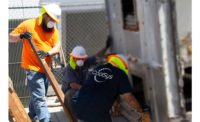As the country continues to recover from the COVID-19 pandemic, building owners, managers, and operators across the country are faced with the formidable task of creating safer, cleaner, and more sanitary environments for occupants — particularly amid the reopening of and return to private and public spaces. In the coming weeks and months, tens of millions of employees will be returning to their workplaces as companies shift back to fully in-person or hybrid work environments. In addition, come this fall, students will head back into classrooms to resume in-person learning.
In light of this mass return, managers, company leaders, and school district administrators should explore all available options to heighten the safety and cleanliness of their respective spaces, especially the air. According to recent survey data, nearly a third of remote workers still feel uncomfortable returning at this time, indicating lingering concerns over their environments following more than a year of heightened attention to health and sanitation.
So, what does this all mean for decision-makers? An increasingly popular demand for facilities, particularly within the HVAC systems, is to disinfect pathogens like viruses in the air of common occupied spaces with science-backed and CDC-recommended ultraviolet germicidal irradiation (UVGI) technology. Trusted for over a hundred years, specific wavelengths of light within the UVC spectrum target the genetic material of microorganisms making replication impossible. Significantly, both ASHRAE and the CDC recommend applying UVC for airborne disinfection of SARS CoV2 within buildings, including schools. Moreover, Steril-Aire UVGI technology addresses other airborne allergens and disease-causing microorganisms, resulting in improved indoor air quality well into the future.
In addition to improved IAQ and clear health benefits, ultraviolet germicidal irradiation (UVGI) technology, such as Steril-Aire UVC solutions, also offers significant maintenance and operational savings with predictable ROI. In an HVAC system, keeping the coils and other components free of organic buildup restores heat exchange efficiency and airflow uniformity and reduces pressure drop across the coils, resulting in a more efficient system and reduced energy consumption.
Optimizing Location of Installation
For the most effective microbial control, the UVC should be installed on the supply side of the system, downstream from the cooling coil and above the drain pan. This location provides more effective biofilm and microbial control than in-duct installations because the UVC irradiates the contaminants at the source and delivers simultaneous decontamination of surface and airborne microorganisms.
Maximizing Chiller Performance
The ability of UVC to eliminate biofilm and other organic build-up on cooling coil surfaces helps to maximize cooling coil heat transfer and thus allows the chiller plant to operate under optimum conditions. By eliminating biofilm and organic build-up between the cooling coil fins, much air resistance is removed. This allows the free flow of air through clean coils and ensures that variable speed-driven fans can operate at much lower speed to conserve energy.
Creating Operational Efficiency and Cost Savings
In addition to reducing energy consumption, UVC provides additional operational efficiency and cost savings. Installed on the supply side of coil, UVC continuously cleans the coils, eliminating the need for costly and time-consuming manual coil and duct cleaning. As a safe and non-toxic solution, UVC also reduces HVAC chemical cost for coil cleaning with no toxic fumes or irritants. Removal of biofilm with UVC not only brings the HVAC equipment performance to the original equipment specification, but it also prolongs the time frame for HVAC equipment replacement and capital investment.
Making a Sustainable Impact
Energy conservation and reduced carbon emissions can also contribute greatly to the value of any UVC installation. Many UVC projects may qualify for government incentives, utility rebates, or reduction in taxes or avoidance of environmental penalties.
Each of these implementation best practices and technical data accumulated during trialing of UVC installations further underscores the technology’s efficacy — a recent test conducted after a Steril-Aire installation found a greater than 10% (15.6-17.9 kW) gain in net cooling capacity with an 8.6-11.8% reduction in cooling coil pressure drop, a 3.9-4.7% improvement in airflow, a 99% reduction of microbes on coil and HVAC surfaces, and a 90-99% reduction in microbes from air and AHU supply air samples.
Ultimately, no two HVAC systems are alike—and decision-makers should adopt a UVGI or UVC implementation strategy that suits their needs best in order to protect people in the places where they live, work, and play.








